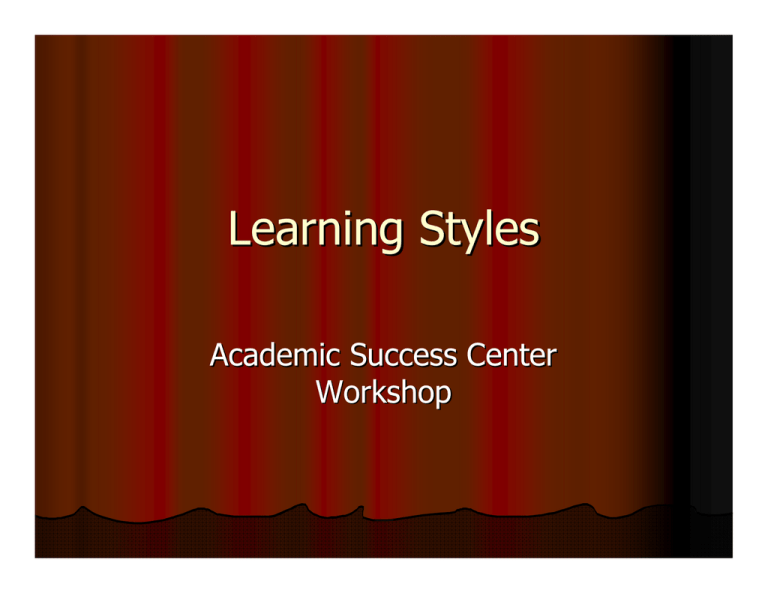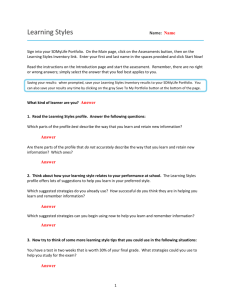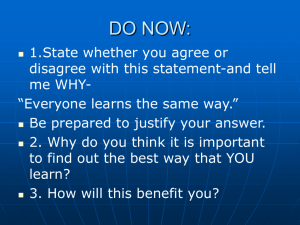Learning Styles Academic Success Center Workshop
advertisement

Learning Styles Academic Success Center Workshop Presentation Overview z Take the UCF Learning Style Inventory to determine your learning style. z Learn about the importance of learning styles. z What does it all mean? Explanations of different learning styles and helpful tips. z Questions? Take a moment… z Please take your time and complete the UCF Learning Style Inventory. z Follow the instructions and read each question and select the best answer. z Use the scoring procedure instructions to find your learning style. The Importance of Learning Styles z Now that you have taken the inventory let’s stop for a moment and discuss what that all means… z Why are learning styles important? z What do they mean? z Why do colleges and universities use them? Learning Styles z Learning Styles are important because they help us to understand the ways we learn. z Understanding your learning style can help you become a better learner. z Smart students learn how to become better students and use their learning style to help them succeed! Did You Know? z Many “Academic Success Centers” or “Learning Centers” at various colleges and universities help students find out their learning style. z Here at USCA students can visit our Academic Success Center and figure out their learning style. z Students also learn about this in AFYS 101. Learning Styles Defined z Now that you know why learning styles are important let’s discuss your results from the inventory. z Here are the (4) types of learning styles you may have-Visual, Auditory/Verbal, Tactile & Kinesthetic. z Some of you may have a combination of multiple styles, that’s OK! Visual Learners z Visual learners learn best from what they see: diagrams, flowcharts, time lines, films, and demonstrations. Tips for Visual Learners z z z z z Add diagrams to your notes whenever possible. Organize notes so that you can clearly see main points and supporting facts and how ideas are connected. Use visual organizers (graphs, charts, symbols, etc.) to help show relationships between concepts/ideas. Color-code notes to help you to see categories of information Use visualization as a way to study/prepare for tests and to retrieve information. Auditory/Verbal Learners z Auditory/Verbal learners gain the most learning from reading, hearing spoken words, participating in discussions, and explaining things to others. Auditory/Verbal learners also learn best listening to lectures and audio tapes. Tips for Auditory/Verbal Learners z z z z z z z z Attend lectures and tutorials. Ask questions to hear more information. Read the textbook and highlight no more than 10%. Record lectures. Rewrite your notes and add what you missed from the tape. Recite or summarize information. Talk about what you learn while working in study groups. Review information by listening to tapes you have recorded. Tactile Learners z Tactile learners learn best by touching. These learners often write things down or study with a pen and draw pictures or diagrams. Tactile learners learn by feeling or touching what they are learning about. Kinesthetic Learners z Kinesthetic learners learn best by “doing” and moving. They prefer to use their body to learn and are active. Most kinesthetic learners use movement to memorize information. Tips for Tactile/Kinesthetic Learners (both groups benefit from these tips because they are both “active” learners) z z z z z z Utilize as many senses as possible while learning. Go to labs, exhibits, tours, etc. to experience the concepts being learned. Study in a group where each person is teaching others about the material he/she knows. Pace and recite while you learn. Act out material or design learning games. Use flash cards with other people. Teaching Styles z It is also important to understand that your professor’s may have different teaching styles. z Think about your classes- what are some of the ways that information is presented to you? z How does this effect your learning? z Do you learn better from one style than another? Left Brain Thinkers z Left Brain (Linear) thinkers find it easiest to learn material presented step by step in a logical, ordered progression. They can work with sections of material without fully understanding the whole picture. Right Brain Thinkers Right Brain (Holistic) thinkers progress in fits and starts. They may feel lost and unable to solve problems, until they can see the big picture and the relationships between ideas. They need to make sense of details. They tend to be creative. Next Steps… z Now that you understand your learning style try to use this information to help you in your classes. z Be flexible and try the tips we talked about to adjust to various teaching styles. z Understanding how you learn is a key step in the process. Resources Information in this workshop was taken from the following resources: z z z z Adapted in part from a web site developed by Richard M. Felder and Barbara A. Solomon, North Carolina State University at: http://www.ncsu.edu/felder-public/ILSpage.html (2006) University of Central Florida Student Success Center http://www.sarc.sdes.ucf.edu/ P.O.W.E.R Learning: Strategies for Success in College Life by Robert Feldman Learning Styles Handout www.how-tostudy.com/LearningStylesPrint.htm Questions Thank you for participating in the Academic Success Center Workshop





